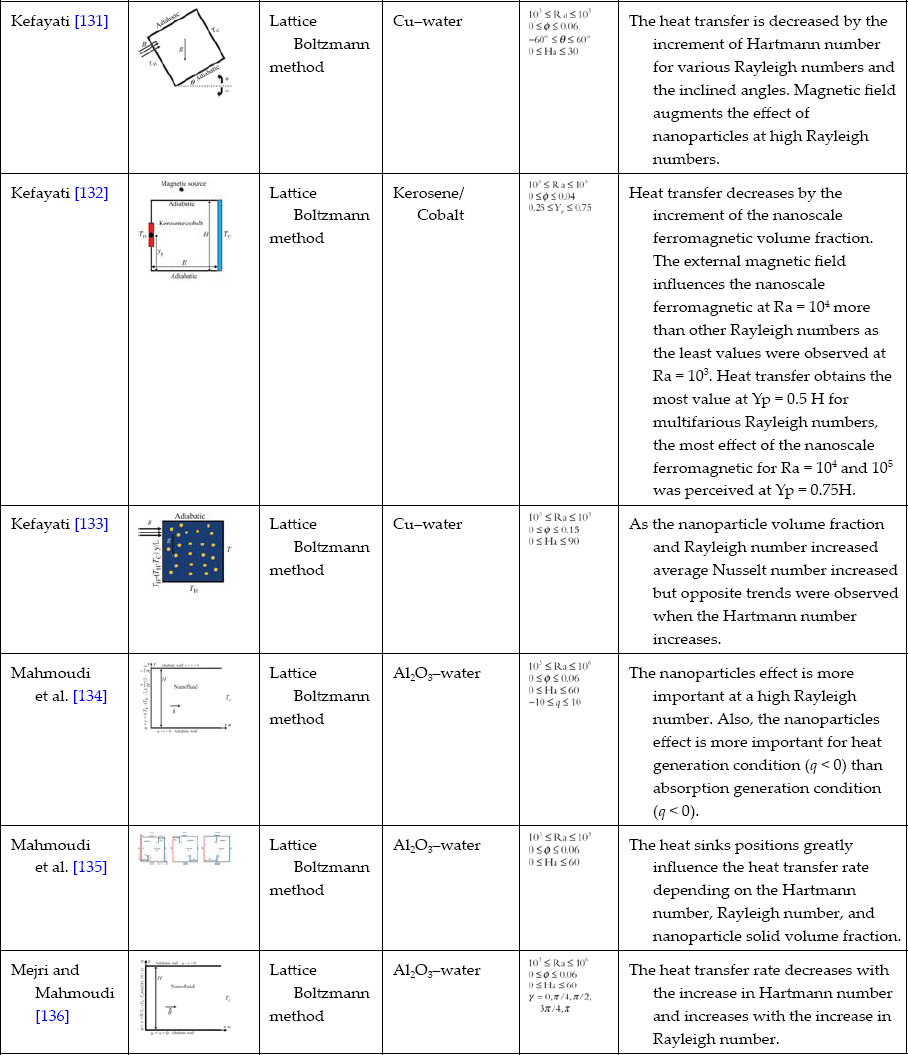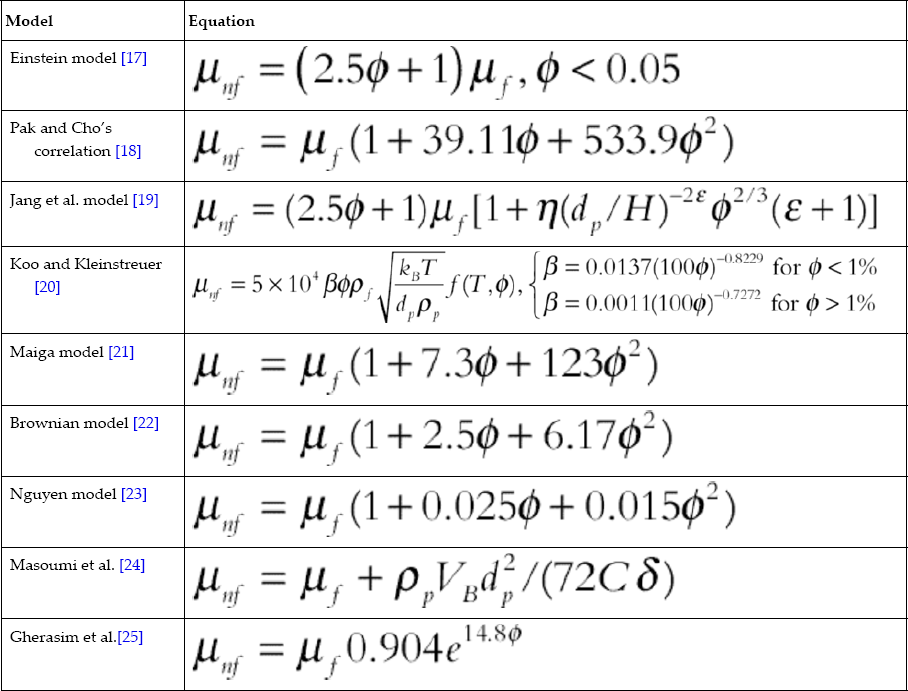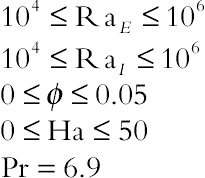Nanofluid: Definition and Applications
Abstract
The use of additives in the base fluid like water or ethylene glycol is one of the techniques applied to augment the heat transfer. Recently innovative nanometer sized particles had been dispersed in the base fluid in heat transfer fluids. The fluids containing the solid nanometer size particle dispersion are called “nanofluids.” Two main categories were discussed in detail: the single-phase modeling in which the combination of nanoparticle and base fluid is considered as a single-phase mixture with steady properties and the two-phase modeling in which the nanoparticle properties and behaviors are considered separately from the base fluid properties and behaviors. Moreover, nanofluid flow and heat transfer can be studied in the presence of thermal radiation, electric field, magnetic field, and porous media. Furthermore, several numerical and semianalytical methods can be used to simulate nanofluid hydrothermal behavior. In this chapter, definition of nanofluid and its application have been presented.
Keywords
1.1. Introduction
1.1.1. Definition of nanofluid
1.1.2. Model description
1.1.3. Conservation equations
1.1.3.1. Single-phase model
1.1.3.2. Two-phase model
1.1.3.2.1. Continuity equation
1.1.3.2.2. Nanoparticle continuity equation
 (1.2)
(1.2)
 (1.3)
(1.3)
 (1.4)
(1.4)1.1.3.2.3. Momentum equation
 (1.5)
(1.5)
1.1.3.2.4. Energy equation
 (1.7)
(1.7)
 (1.8)
(1.8)
 (1.10)
(1.10)
 (1.12)
(1.12)1.1.4. Physical properties of the nanofluids for single-phase model
1.1.4.1. Density
1.1.4.2. Specific heat capacity
1.1.4.3. Thermal expansion coefficient
1.1.4.4. The electrical conductivity
1.1.4.5. Dynamic viscosity
 (1.20)
(1.20)1.1.4.6. Thermal conductivity
Table 1.2
Different models for thermal conductivity of nanofluids used in simulation
| Model | Equation |
| Koo and Kleinstreuer [20] |

|
| Jang and Choi model [26] |

|
| Bruggeman model [27] |

|
| Chon et al. model [28] |
|
| Charuyakorn et al.[29] |

|
| Stationary model [30] |
|
| Yu and Choi [31] |

|
| Patel et al. [32] |

|
| Mintsa et al. [33] |
|

Table 1.3
The thermo physical properties of the nanofluid
| ρ (kg/m3) | Cp (j/kgk) | k (W/m.k) | β (K−1) | σ (Ω·m)−1 | |
| Pure water | 997.1 | 4179 | 0.613 | 21 × 10−5 | 0.05 |
| Copper (Cu) | 8933 | 385 | 401 | 1.67 × 10−5 | 5.96 × 10−7 |
| Silver (Ag) | 10 500 | 235 | 429 | 1.89 × 10−5 | 3.60 × 10−7 |
| Alumina (Al2O3) | 3970 | 765 | 40 | 0.85 × 10−5 | 1 × 10−10 |
| Titanium oxide (TiO2) | 4250 | 686.2 | 8.9538 | 0.9 × 10−5 | 1 × 10−12 |

1.2. Simulation of nanofluid flow and heat transfer
1.2.1. Semianalytical methods
Table 1.4
Summary of the semianalytical method studies on nanofluid
| Authors | Geometry of study | Method | Type of nanofluid | Properties | Remarks |
| Sheikholeslami et al. [37] |

|
Least square and Galerkin methods | Cu–water |
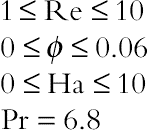
|
Velocity boundary layer thickness decreases with increase in Reynolds number and increases with increase in Hartmann number |
| Sheikholeslami et al. [38] |
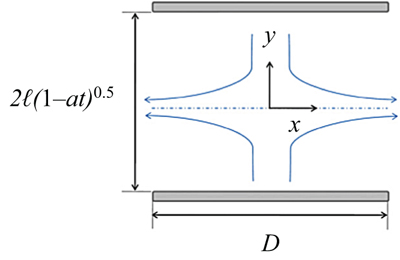
|
Adomian decomposition method | Cu–water Ag–water Al2O3–water TiO2–water |

|
Nusselt number increases with increase in nanoparticle volume fraction and Eckert number but it decreases with increase in the squeeze number |
| Sheikholeslami and Ganji [39] |

|
HPM | Cu–water |
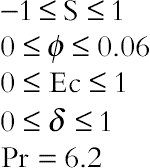
|
Nusselt number has direct relationship with nanoparticle volume fraction,
|
| Sheikholeslami et al. [40] |

|
ADM | Cu–water |

|
In greater angles or Reynolds numbers high Hartmann numbers are needed to reduce backflow |
| Sheikholeslami et al. [41] |

|
HAM | Cu–water |

|
For both suction and injection, the heat transfer rate at the surface increases with increase in nanoparticle volume fraction, Reynolds number, and injection/suction parameter and it decreases with power of rotation parameter |
| Sheikholeslami et al. [42] |

|
HAM | Cu–water Ag–water Al2O3–water TiO2–water |

|
Increase in the nanoparticle volume fraction will decrease momentum boundary layer thickness and entropy generation rate while this increases the thermal boundary layer thickness. Such effects are found to be more noticeable in the Ag–water solution than in the other solutions. |
| Sheikholeslami and Ganji [43] |

|
Galerkin optimal homotopy asymptotic method | Cu–water |
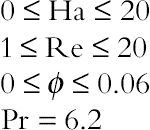
|
Velocity boundary layer thickness decreases with increase in Reynolds number and nanoparticle volume fraction and increases with increase in Hartmann number. |
| Sheikholeslami et al. [44] |
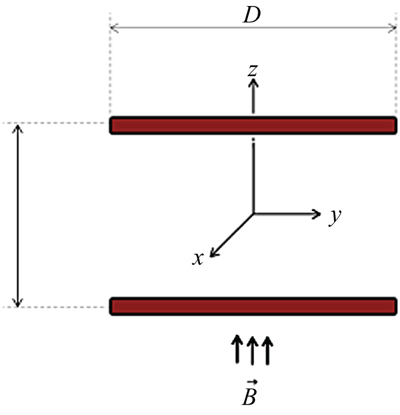
|
HPM | Al2O3–water |
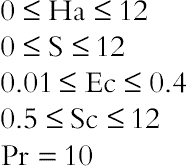
|
Nusselt number is an increasing function of Hartmann number, Eckert number, and Schmidt number but it is a decreasing function of squeeze number |
| Sheikholeslami and Ganji [45] |

|
DTM | CuO–water, Al2O3–water |

|
Skin friction coefficient increases with increase in the squeeze number and Hartmann number but it decreases with increase in nanofluid volume fraction. Nusselt number increases with augment of nanoparticle volume fraction, Hartmann number while it decreases with increase in the squeeze number |
| Sheikholeslami et al. [46] |
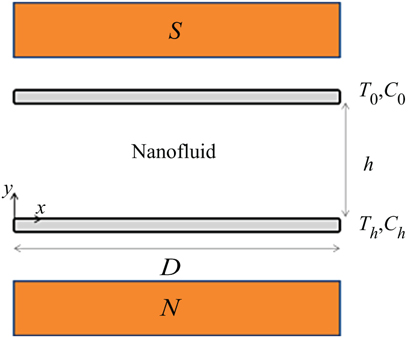
|
DTM | Al2O3–water |

|
Nusselt number augments with increase of viscosity parameters but it decreases with augment of magnetic parameter, thermophoretic parameter, and Brownian parameter |
| Domairry et al. [47] |

|
DTM | Cu–water |

|
As the nanoparticle volume fraction increases, the momentum boundary layer thickness increases, whereas the thermal boundary layer thickness decreases |
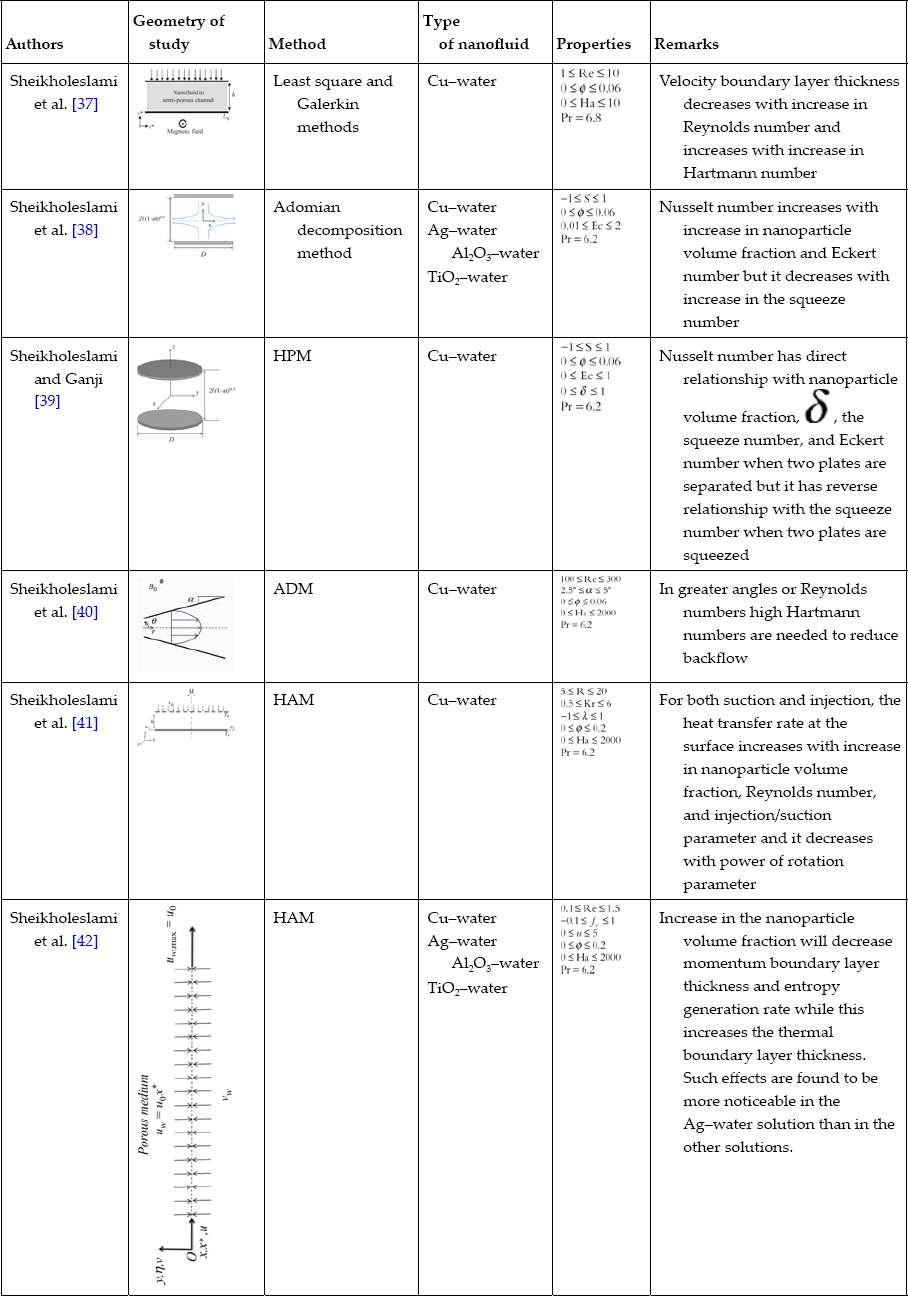

ADM, Adomian decomposition method; DTM, differential transformation method; HAM, homotopy analysis method; HPM, homotopy perturbation method.
1.2.2. Runge–Kutta method
Table 1.5
Summary of the Runge–Kutta method studies on nanofluid
| Authors | Geometry of study | Method | Type of nanofluid | Properties | Remarks |
| Malvandi et al. [48] |

|
Runge–Kutta–Fehlberg method | Cu–water, Al2O3–water and TiO2–water nanofluids |

|
Cu–water nanofluids exhibits a better thermal performance among the other considered nanofluids. Slip velocity at the walls increases the heat transfer rate. |
| Malvandi [49] |

|
Runge–Kutta–Fehlberg method | Nonhomogeneous mixtures |

|
Increasing the thermophoresis is found to decrease heat transfer and concentration rates. This decrease suppresses for higher thermophoresis number. In addition, it was observed that unlike the heat transfer rate, a rise in Brownian motion leads to an increase in concentration rate |
| Ashorynejad et al. [50] |

|
Fourth order Runge–Kutta method | Cu–water Ag–water Al2O3–water TiO2–water |
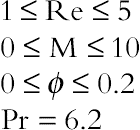
|
Choosing copper (for small values of magnetic parameter) and alumina (for large values of magnetic parameter) leads to the highest cooling performance for this problem |
| Sheikholeslami and Ganji [51] |
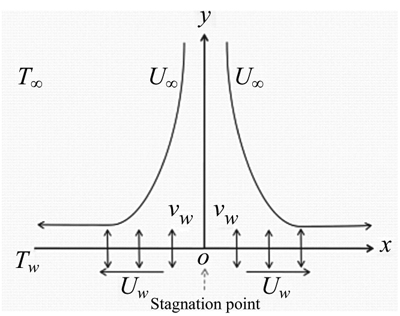
|
Fourth order Runge–Kutta method | Cu–water Ag–water Al2O3–water TiO2–water Cu–EG |

|
Choosing titanium oxide as the nanoparticle and EG as base fluid proved to have the highest cooling performance for this problem. |
| Sheikholeslami and Ganji [52] |

|
Fourth order Runge–Kutta method | Al2O3–water |

|
Nusselt number has direct relationship with Reynolds number while it has reverse relationship with rotation parameter, magnetic parameter, Schmidt number, thermophoretic parameter, and Brownian parameter |
| Sheikholeslami et al. [53] |
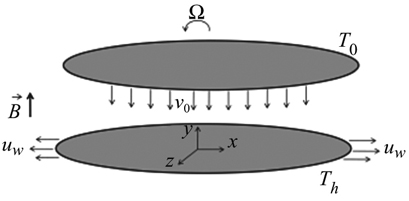
|
Fourth order Runge–Kutta method | Cu–water Ag–water Al2O3–water TiO2–water |

|
The highest values are obtained when titanium oxide is used as nanoparticle. Also it can be found that Nusselt number decreases with increase of magnetic parameter due to presence of Lorentz forces. |
| Sheikholeslami and Ganji [54] |

|
Fourth order Runge–Kutta method | Al2O3–water |
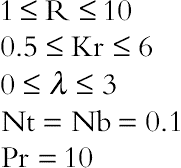
|
Nusselt number has direct relationship with Reynolds number and injection parameter while it has reverse relationship with rotation parameter, Schmidt number, thermophoretic parameter, and Brownian parameter |
| Sheikholeslami and Ganji [55] |

|
Fourth order Runge–Kutta method | Al2O3–water |

|
Concentration boundary layer thickness increases with increase of radiation parameter |
| Sheikholeslami et al. [56] |

|
Fourth order Runge–Kutta method | CuO–water, Al2O3–water |
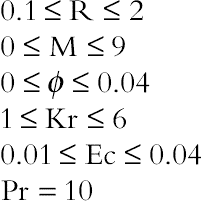
|
The magnitude of the skin friction coefficient is an increasing function of the magnetic parameter, rotation parameter, and Reynolds number and it is a decreasing function of the nanoparticle volume fraction |
| Sheikholeslami et al. [57] |

|
Fourth order Runge–Kutta method | Al2O3–water |

|
Nusselt number has direct relationship with radiation parameter and Reynolds number while it has reverse relationship with other active parameters. Also it can be found that concentration boundary layer thickness decreases with the increase of radiation parameter |
Sheikholeslami |
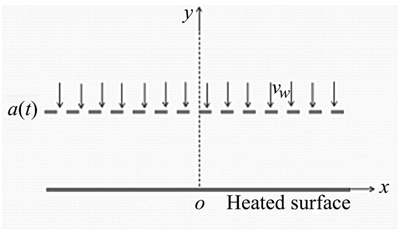
|
Fourth order Runge–Kutta method | Al2O3–water |

|
Heat transfer enhancement has direct relationship with Reynolds number when power law index is equal to zero but opposite trend is observed for other values of power law index. |
Sheikholeslami |
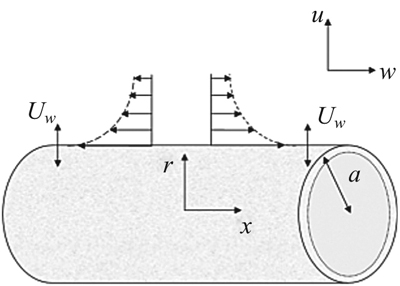
|
Fourth order Runge–Kutta method | CuO–water, Al2O3–water |

|
Adding nanoparticle into the base fluid of this problem is capable of changing the flow pattern. It is found that Nusselt number is an increasing function of nanoparticle volume fraction, suction parameter, Reynolds number |
| Sheikholeslami and Abelman [60] |

|
Fourth order Runge–Kutta method | Al2O3–water |

|
Nusselt number has a direct relationship with the aspect ratio and Hartmann number but it has a reverse relationship with the Reynolds number, Schmidt number, Brownian parameter, thermophoresis parameter, and Eckert number. |
| Sheikholeslami et al. [61] |

|
Fourth order Runge–Kutta method | Al2O3–water |

|
Nusselt number is an increasing function of each active parameter. Latent heat has a direct relationship with Schmidt number, Brownian parameter, and thermophoretic parameter but it has reverse relationship with normalized thickness. |
| Sheikholeslami et al. [62] |

|
Fourth order Runge–Kutta method | Cu–water |
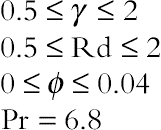
|
Skin friction coefficient increases with increase in Reynolds number and suction parameter but it decreases with increase in nanoparticle volume fraction |
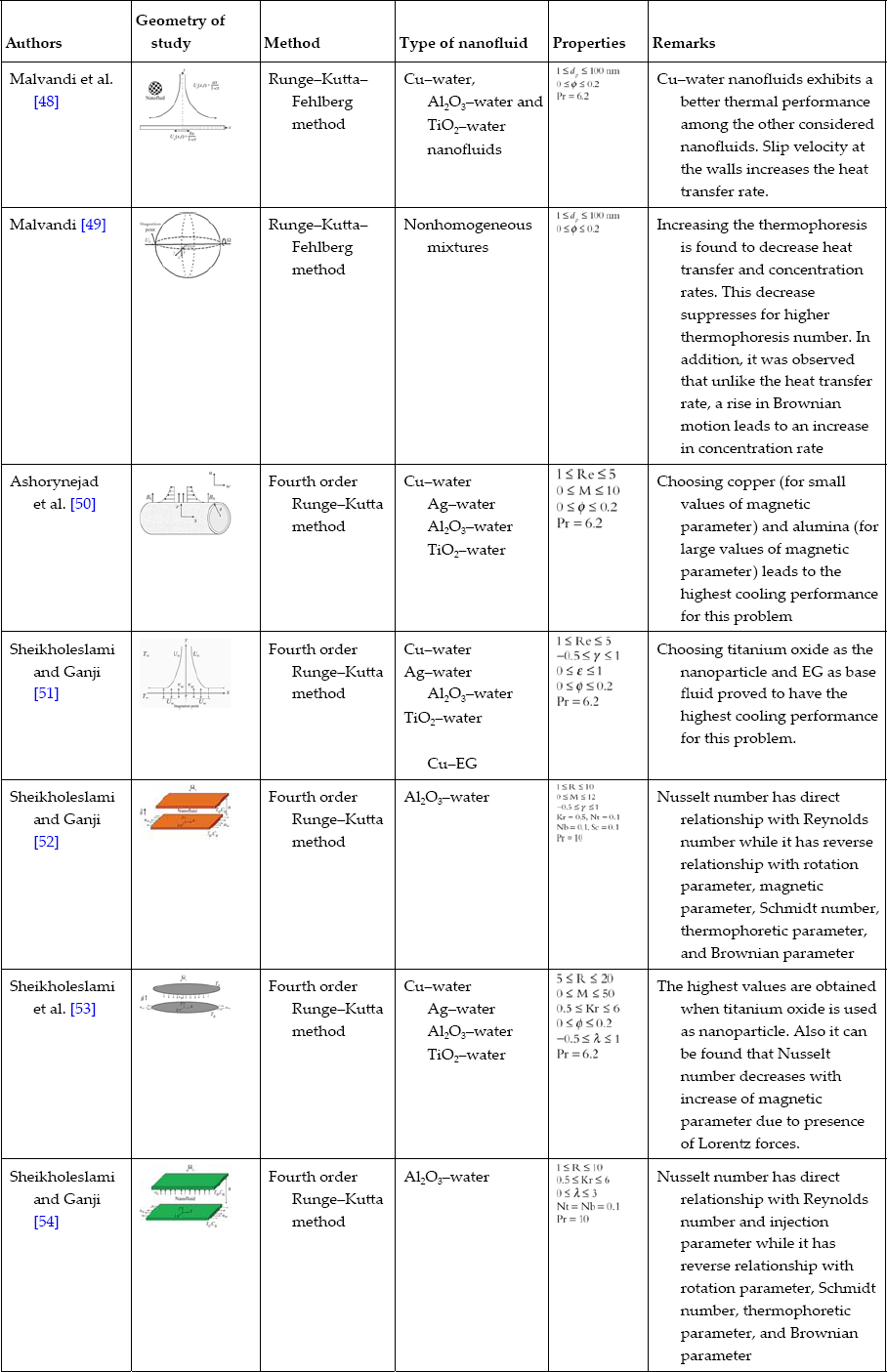


1.2.3. Finite difference method
Table 1.6
Summary of the finite difference method studies on nanofluid
| Authors | Geometry of study | Method | Type of nanofluid | Properties | Remarks |
| Sheremet and Pop [65] |

|
Finite difference method | Porous cavity with water-based nanofluid | Ra = 100–500; Le = 1–10; Nb = 0.1–0.4; Nt = 0.1–0.4; Nr = 0.1–0.4; Kr = 0.1–10.0; D = 0.1–0.3. | High thermophoresis parameter, low Brownian motion parameter, low Lewis and Rayleigh numbers, and high thermal conductivity ratio reflect essential nonhomogeneous distribution of the nanoparticles inside the porous cavity. |
| Sheremet et al. [66] |
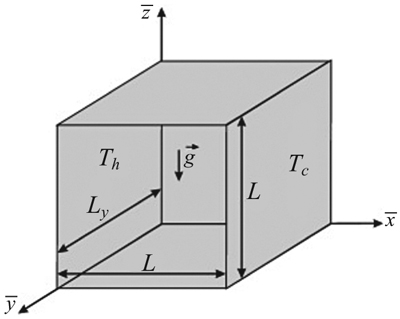
|
Finite difference method | Porous cavity with water-based nanofluid | Ra = 30–500, Le = 1–10, Nr = 0.1–0.4, Nb = 0.1–0.4, Nt = 0.1–0.4, aspect ratio (A = 0.2–5.0). | Average Nusselt number at the hot surface is an increasing function of the Rayleigh number and Brownian motion parameter, and a decreasing function of the Lewis number, buoyancy-ratio and thermophoresis parameters. The average Sherwood number at the hot surface is an increasing function of the Rayleigh number and thermophoresis parameter, and a decreasing function of the Lewis number, buoyancy-ratio, and Brownian motion parameters. |
| Sheremet et al. [67] |

|
Finite difference method | Cu–water | Ra = 10–500, ϕ = 0.0–0.05, porosity of porous medium (ɛ = 0.1–0.8), thermal stratification parameter (b = 0–1.0) solid matrix of the porous medium (aluminum foam and glass balls) | An increase in the thermal stratification parameter leads to an essential reduction of the convective core sizes, displacement of this core close to the lower left corner and rotation of this vortex along the horizontal axis. More intensive attenuation of convective flow with ɛ and b occurs for low thermal conductivity material for the solid matrix of the porous medium. |
| Ghalambaz et al. [68] |

|
Finite difference method | Cu–water | −60° < α < 60°, aspect ratio 0.1 < A < 10, 10 < Ra <1000, 0 < ϕ < 0.1, ɛ = 0.3, 0.5, 0.7, ks = 2kbf |
Presence of nanoparticles deteriorates the heat transfer in all studied cases. The decrease of the porosity increases the porous matrix thermal conductivity while the decrease of the inclination angle and of the aspect ratio would boost the deterioration of heat transfer. |
| Sheremet et al. [69] |
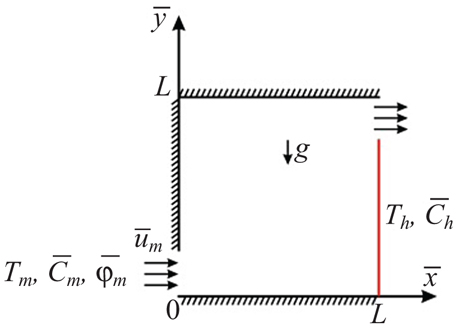
|
Finite difference method | Porous cavity with water-based nanofluid | Re = 10–100, Pr = 0.2, Ra = 50–500, usual Lewis number (Le = 1–50), Dufour-contaminant Lewis number (Ld = 1–50), nanofluid Lewis number (Ln = 1–50), Nr = 0.1–0.4, regular double-diffusive buoyancy ratio (Nc = 0.1–0.4), Nb = 0.1–0.4, Nt = 0.1–0.4, modified Dufour parameter (Nd = 0.1–0.4) | Average Nusselt number at hot vertical wall is an increasing function of the Rayleigh and Reynolds numbers, and a decreasing function of the usual Lewis number. While the average Sherwood number at this vertical wall is an increasing function of the usual Lewis. Effects of the Rayleigh and Reynolds numbers on
|
| Sheremet and Pop [70] |

|
Finite difference method | Porous cavity with water-based nanofluid | Ra = 100–500; Le = 1–10; Nb = 0.1–0.4; Nt = 0.1–0.4; Nr = 0.1–0.4; A = H/L = 1.0. | Average Nusselt number is an increasing function of Ra, Le, and a decreasing function of Nr, Nb, Nt. At the same time the average Sherwood number is an increasing function of Ra, Le, Nb, Nt and a decreasing function of Nr. |
| Sheremet and Pop [71] |

|
Finite difference method | Cu–water | Ra = 200–700, ɛ = 0.1–0.8, ϕ = 0.0–0.05, the annulus radius ratio (R = 1.5, 2.0, 2.5), solid matrix of porous medium (aluminum foam and glass balls) |
Average Nusselt number is an increasing function of the Rayleigh number and annulus radius ratio and a decreasing function of the porosity of porous medium regardless of the solid matrix material. A decrease in the thermal conductivity of the solid matrix material leads to an attenuation of the convective heat transfer inside the annulus for high values of the porosity and solid volume fraction of nanoparticles. |
| Sheremet et al. [72] |
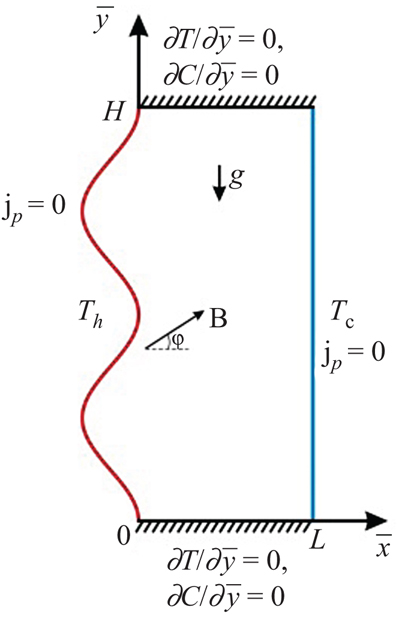
|
Finite difference method | Water-based nanofluid | Ra = 105, Le = 10, Pr = 6.26, Nr = 0.1, Nb = 0.1, Nt = 0.1, A = 1, Ha = 0–100, undulation number (κ = 1–3), wavy contraction ratio (b = 0.1–0.3), ϕ = 0–π, τ = 0–0.13. |
An increase in the Hartmann number leads to an attenuation of convective flow and heat transfer and a formation of a double-core convective cell for high values of Ha. An increase in the wavy contraction ratio leads to an increase in the wave amplitude and an attenuation of the convective flow with more intensive heating of the wavy troughs. |
| Khan et al. [73] |
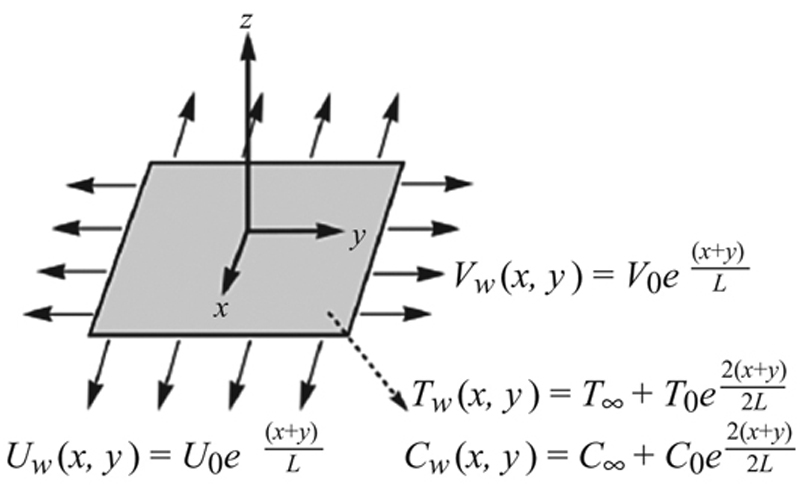
|
Finite difference scheme known as Keller-box method | Water-based nanofluid |
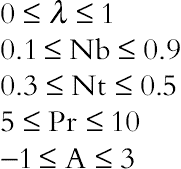
|
The existence of interesting Sparrow–Gregg-type hills for temperature distribution corresponding to some range of parametric values |
Kai-Long Hsiao |
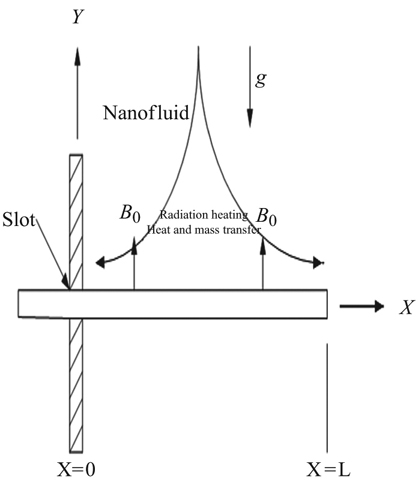
|
An improved finite-difference with Box method | Cu–water | K = 400 (W/mK)
|
The results show that dimensionless heat transfer effects increase with increasing values of Pr, R0, Nb, or G but decrease with increasing M, Nt, or Ec. Those parameters Pr, R0, Nb, or G are important factors in this study for increasing the heat transfer effects. The fourth, for mass transfer that the values Sc and Nb can obtain a good mass diffusion effect, but the parameter Nt has not processed this kind of function. |
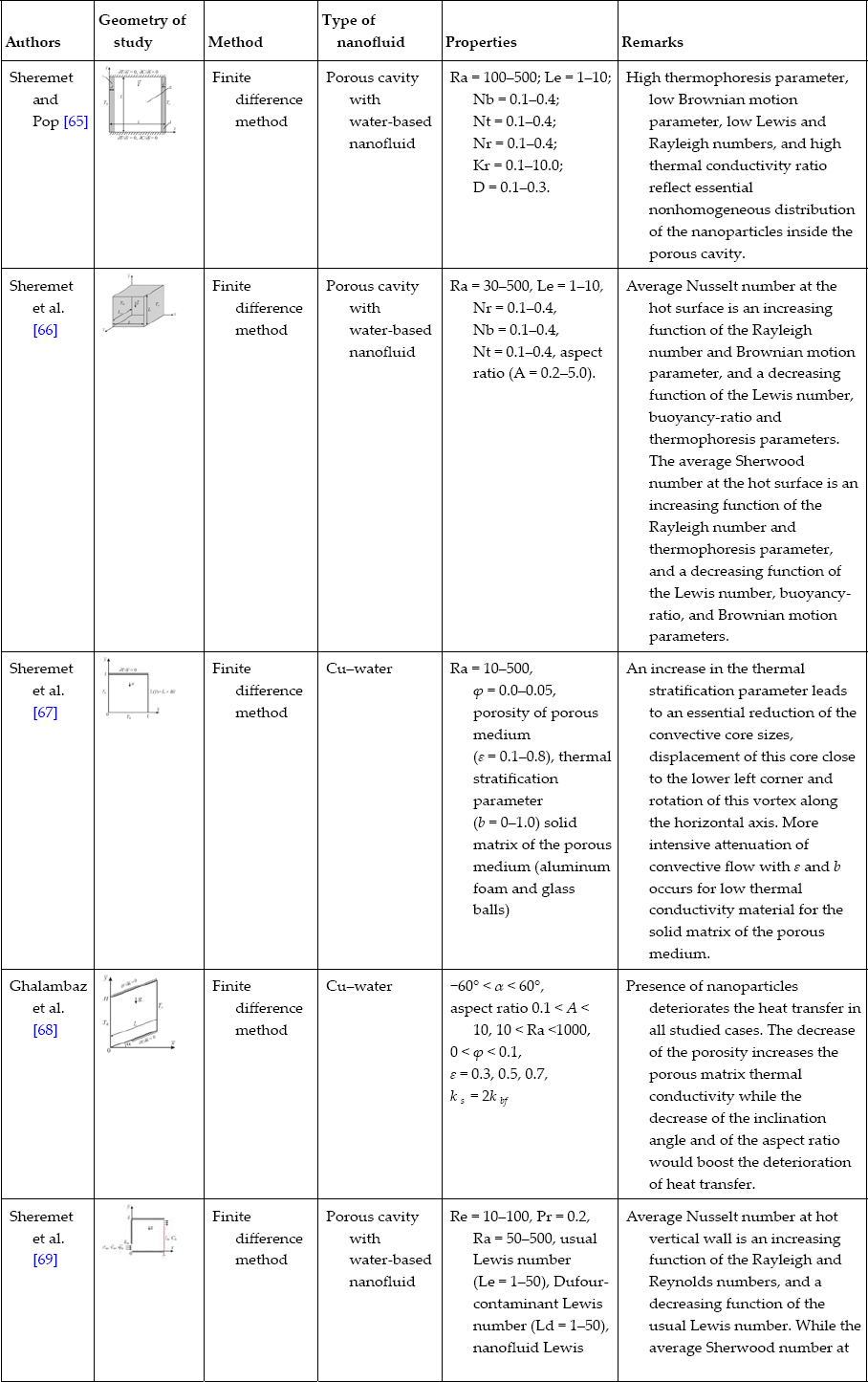


1.2.4. Finite volume method
Table 1.7
Summary of the Finite volume method studies on nanofluid
| Authors | Geometry of study | Method | Type of nanofluid | Properties | Remarks |
| Garoosi and Hoseininejad [75] |
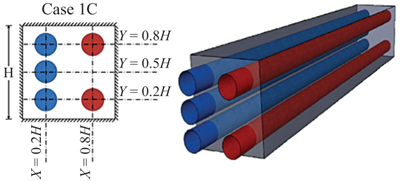
|
Finite volume method |
Cu–water TiO2–water Al2O3–water |

|
Changing the location of the heat source/sink from bottom–top to top–bottom configuration decreases the heat transfer rate significantly. |
| Garoosi et al. [76] |

|
Finite volume method |
Al2O3–water |
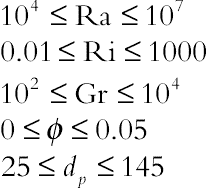
|
At low Rayleigh numbers and high Richardson numbers, the particle distribution is fairly nonuniform while at high Ra and low Ri values particle distribution remains almost uniform for free and mixed convection cases, respectively |
| Garoosi et al. [77] |
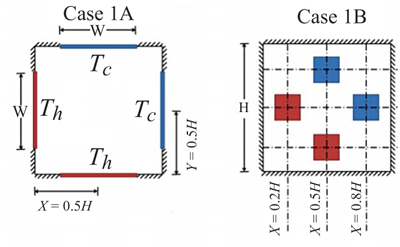
|
Finite volume method |
Cu–water TiO2–water Al2O3–water |

|
Thermophoretic effects are negligible for nanoparticles with high thermal conductivity. As a result, in such conditions use of homogeneous and single-phase models is valid at any Ra and Ri |
| Teamah et al. [78] |

|
Finite volume method |
Water-based nanofluid |

|
Weak magnetic field; the addition of nanoparticles is necessary to enhance the heat transfer but for strong magnetic field there is no need for nanoparticles because the heat transfer will decrease. |
| Santra et al.[79] |
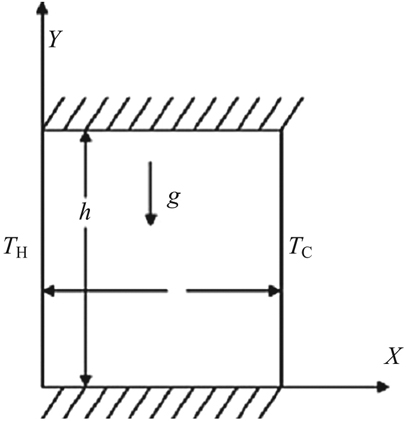
|
Finite volume method |
Cu–water |

|
The heat transfer rate decreases with increase in solid volume fraction for a particular Rayleigh number. However, it increases with Rayleigh number for a particular solid volume fraction. |
Das and Ohal |
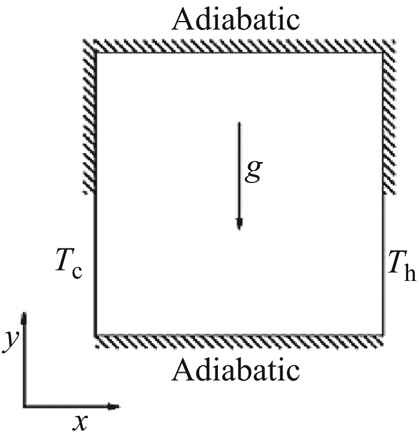
|
Finite volume method |
Cu–water |

|
The rate of heat transfer increases with an increase in the nanoparticles volume fraction |
| Oztop et al. [81] |

|
Finite volume method |
Cu–water TiO2–water Al2O3–water |

|
An enhancement in heat transfer rate was registered for the whole range of Rayleigh numbers |

1.2.5. Finite element method
Table 1.8
Summary of the finite element method studies on nanofluid
| Authors | Geometry of study | Method | Type of nanofluid | Properties | Remarks |
| Selimefendigil and Oztop [82] |

|
Finite element method | Cu–water |
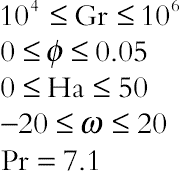
|
Local and average heat transfer and total entropy generation enhance as the solid volume fraction of nanoparticle and angular rotational speed of the cylinder increases and Hartmann number decreases. Heat transfer enhancements around 30% are achieved for the highest volume fraction compared to base fluid. |
| Selimefendigil and Oztop [83] |
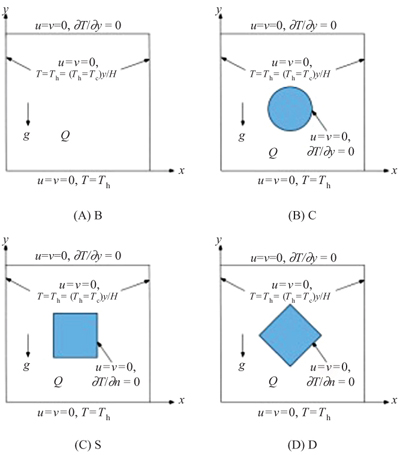
|
Finite element method | Cu–water |
|
As the value of the external Rayleigh number decreases, internal Rayleigh number and Hartmann number increase, average heat transfer enhance. Average Nusselt number enhances by about 40%–60% at the highest solid volume fraction when compared to base fluid with different obstacles installed within the cavity. |
| Selimefendigil and Oztop [84] |

|
Finite volume method | Al2O3–water |
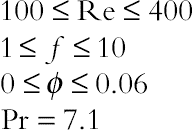
|
The combined effect of pulsation and inclusion of nanoparticles is not favorable for the stagnation point heat transfer enhancement for some combinations of Reynolds number and nanoparticle volume fraction. |
| Selimefendigil and Oztop [85] |

|
Finite element method | Cu–water |
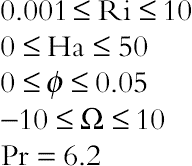
|
Average heat transfer enhances with Richardson number, nanoparticle volume fraction, and cylinder rotation while magnetic field reduces the convection. The combined effect of magnetic field and cylinder rotation acts in a way to enhance local heat transfer for some locations along the heated wall. |
| Selimefendigil and Oztop [86] |

|
Finite element method | Al2O3–water |

|
Cylinder rotation affects the flow and thermal patterns behind the step. The addition of the nanoparticles enhances the averaged heat transfer along the bottom wall downstream of the step. There is almost a linear relation between heat transfer enhancement and nanoparticle volume fraction. |
| Selimefendigil and Öztop [87] |

|
Finite element method | SiO2–water |

|
Average Nussetl number enhances with external Rayleigh number and nanoparticle volume fraction while the opposite behavior is seen as the value of internal Rayleigh number and flexibility of the wall increases. Among different nanoparticle types cylindrical ones show the best performance in terms of heat transfer enhancement. |
| Selimefendigil and Oztop [88] |

|
Finite element method | Al2O3–water and CuO–water |

|
As the value of the Grashof number, thermal conductivity ratio (Kr) and nanoparticle volume fraction increase, average Nusselt number increase. When nanoparticles with low thermal conductivity on the right cavity are added it is more effective for the heat transfer enhancement compared to adding nanoparticles with high thermal conductivity. |


1.2.6. Control volume–based finite element method
Table 1.9
Summary of the control volume–based finite element method studies on nanofluid
| Authors | Geometry of study | Method | Type of nanofluid | Properties | Remarks |
| Sheikholeslami et al. [89] |
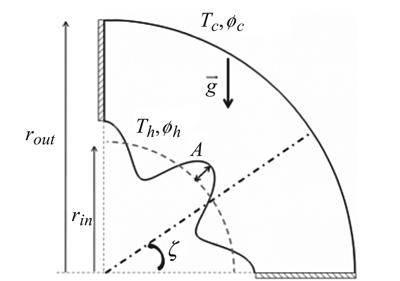
|
Control volume–based finite element method | Al2O3–water |
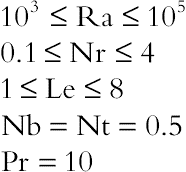
|
Average Nusselt number decreases as buoyancy ratio number increases until it reaches a minimum value and then starts increasing. As Lewis number increases, this minimum value occurs at higher buoyancy ratio number. |
| Sheikholeslami et al. [90] |
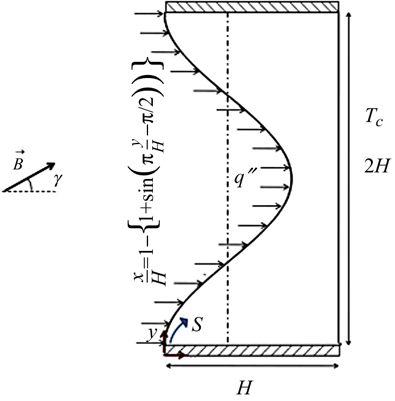
|
Control volume– based finite element method | CuO–water |
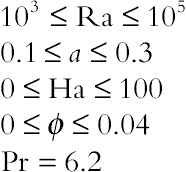
|
Nusselt number is an increasing function of nanoparticles volume fraction, dimensionless amplitude of the sinusoidal wall, and Rayleigh number while it is a decreasing function of Hartmann number |
| Sheikholeslami et al. [91] |
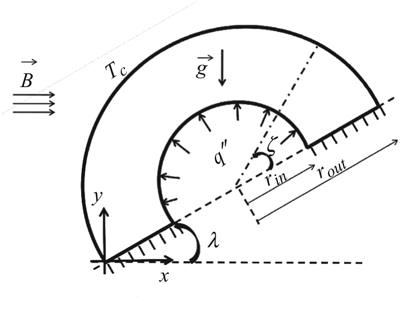
|
Control volume– based finite element method | Cu–water |
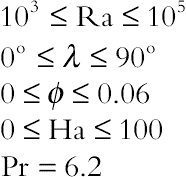
|
Hartmann number and the inclination angle of the enclosure can be control parameters at different Rayleigh numbers. In the presence of magnetic field velocity field retarded and hence convection and Nusselt number decreases |
| Sheikholeslami et al. [92] |

|
Control volume–based finite element method | Cu–water |

|
At Ra = 103, maximum value of enhancement for low Hartmann number is obtained at γ = 0°, but for higher values of Hartmann number, maximum values of E occur at γ = 90° |
| Sheikholeslami et al. [93] |
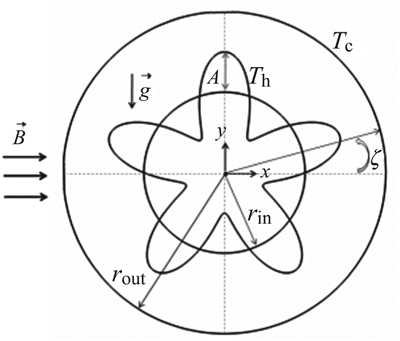
|
Control volume– based finite element method | Cu–water |

|
Nusselt number is an increasing function of nanoparticle volume fraction, the number of undulations, and Rayleigh numbers while it is a decreasing function of Hartmann number. |
| Soleimani et al. [94] |

|
Control volume– based finite element method | Cu–water |

|
There is an optimum angle of turn in which the average Nusselt number is maximum for each Rayleigh number. Moreover, the angle of turn has an important effect on the streamlines, isotherms, and maximum or minimum values of local Nusselt number |
| Sheikholeslami et al. [95] |
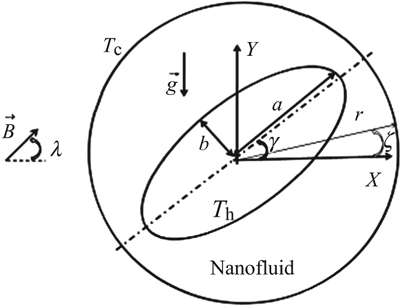
|
Control volume– based finite element method | Cu–water |
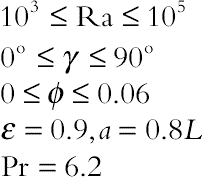
|
Increasing Rayleigh number leads to decrease in heat transfer enhancement while opposite trend is observed with augment of Hartmann number |
| Sheikholeslami et al. [96] |

|
Control volume– based finite element method | Al2O3–water |
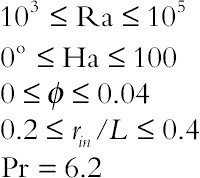
|
Domination of conduction mechanism causes heat transfer enhancement to increase. So enhancement in heat transfer increases with increase in Hartmann number and aspect ratio while it decreases with augment of Rayleigh number |
| Sheikholeslami et al. [97] |

|
Control volume– based finite element method | Al2O3–water |

|
The heat transfer between cold and hot regions of the enclosure cannot be well understood by using isotherm patterns so heatline visualization technique is used to find the direction and intensity of heat transfer in a domain. |
| Sheikholeslami et al. [98] |

|
Control volume– based finite element method | Al2O3–water |
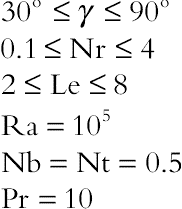
|
Lewis number has no significant effect on Nusselt number at low values of buoyancy ratio number |
| Sheikholeslami et al. [99] |

|
Control volume– based finite element method | Al2O3–water |

|
As buoyancy ratio number increases the effects of other active parameters are more pronounced |
| Sheikholeslami et al. [100] |

|
Control volume– based finite element method | Cu–water |

|
The results show that for Ra = 104 the maximum and minimum average Nusselt number are corresponding to ζ = −45° and 45° respectively, whereas opposite trend is observed for Ra = 105. |
| Sheikholeslami and Ganji [101] |
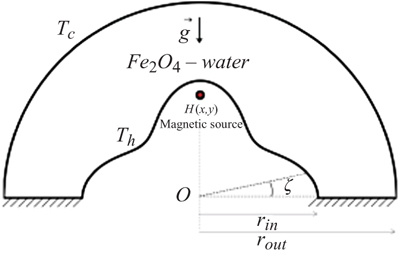
|
Control volume– based finite element method | Fe3O4–water |

|
Nusselt number increases with augment of Rayleigh number and nanoparticle volume fraction but it decreases with increase in Hartmann number. Magnetic number has different effect on Nusselt number corresponding to Rayleigh number |
| Sheikholeslami et al. [102] |

|
Control volume– based finite element method | Fe3O4–water |

|
Nusselt number is an increasing function of Rayleigh number, nanoparticle volume fraction, magnetic number while it is a decreasing function of Hartmann number and radiation parameter. |
| Sheikholeslami Kandelousi [103] |

|
Control volume– based finite element method | Fe3O4–water |
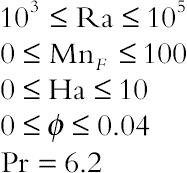
|
Enhancement in heat transfer decreases with increase in Rayleigh number and magnetic number but increases with increase in Hartmann number. |
| Sheikholeslami et al. [104] |
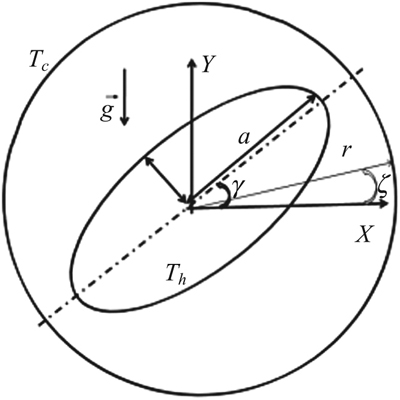
|
Control volume– based finite element method | CuO–water |
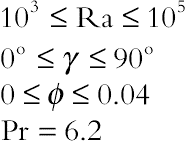
|
Increase in Rayleigh number leads to decrease in ratio of heat transfer enhancement. For high Rayleigh number the minimum heat transfer enhancement ratio occurs at γ = 90°. |
| Sheikholeslami and Rashidi [105] |

|
Control volume– based finite element method | Fe3O4–water |

|
Nusselt number is an increasing function of magnetic number, Rayleigh number, and nanoparticle volume fraction while it is a decreasing function of Hartmann number |
| Sheikholeslami et al. [106] |
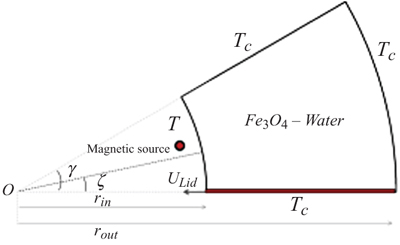
|
Control volume– based finite element method | Fe3O4–water |

|
Nusselt number has direct relationship with Reynolds number, nanoparticle volume fraction while it has reverse relationship with Hartmann number |
| Sheikholeslami and Ellahi [107] |

|
Control volume– based finite element method | Fe3O4–EG |
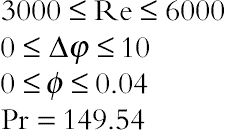
|
Heat transfer rises with augment of supplied voltage and Reynolds number |
| Sheikholeslami et al. [108] |
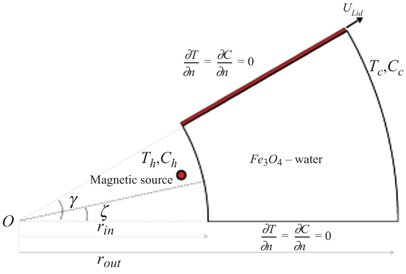
|
Control volume– based finite element method | Fe3O4–water |

|
Nusselt number has direct relationship with Reynolds number while it has reverse relationship with Hartmann number and Lewis number |
| Sheikholeslami et al. [109] |

|
Control volume– based finite element method | Fe3O4–water |
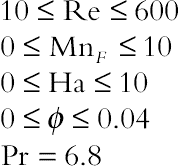
|
Effects of Kelvin forces are more pronounced for high Reynolds number. Heat transfer enhancement has direct relationship with the Reynolds number and the magnetic number while it has inverse relationship with the Hartmann number |
| Sheikholeslami et al. [110] |
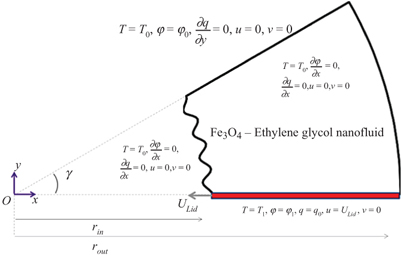
|
Control volume– based finite element method | Fe3O4–EG |

|
Effect of electric field on heat transfer is more pronounced at low Reynolds number. |
| Sheikholeslami and Rashidi [111] |

|
Control volume– based finite element method | Fe3O4–water |

|
Nusselt number has direct relationship with Rayleigh number, buoyancy ratio number, and Lewis number while it has reverse relationship with Hartmann number |
| Sheikholeslami, and Rashidi [112] |

|
Control volume– based finite element method | Fe3O4–water |
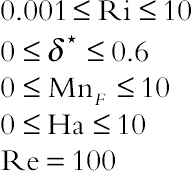
|
Nusselt number has direct relationship with Richardson number, nanoparticle volume fraction while it has reverse relationship with Hartmann number and magnetic number |


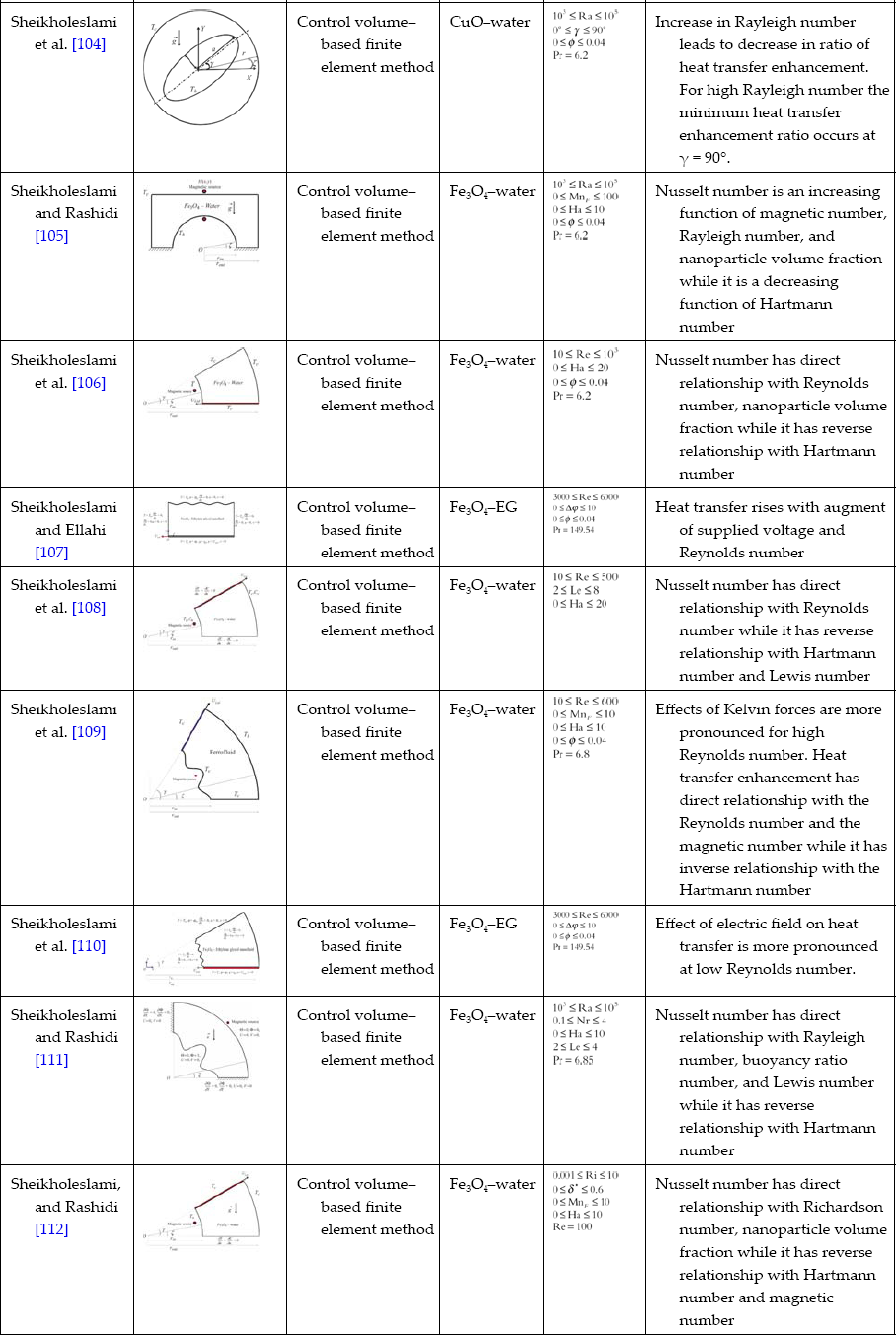
1.2.7. Lattice Boltzmann method
Table 1.10
Summary of the lattice Boltzmann method studies on nanofluid
| Authors | Geometry of study | Method | Type of nanofluid | Properties | Remarks |
| Sheikholeslami et al. [113] |
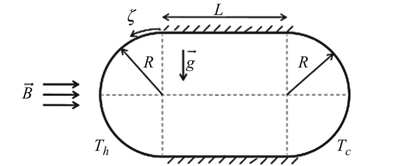
|
Lattice Boltzmann method | Al2O3–water |
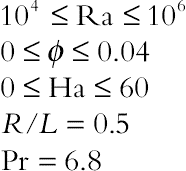
|
Enhancement in heat transfer increases with increase in Hartmann number except for Ra = 104 in which Ha = 40 roles as a critical Hartmann number |
| Sheikholeslami et al. [114] |
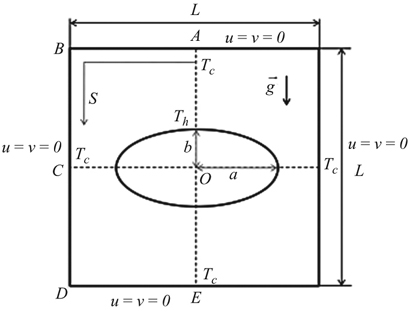
|
Lattice Boltzmann method | Cu–water |
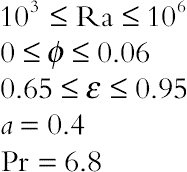
|
The minimum value of enhancement of heat transfer occurs at ɛ = 0.95 for Ra = 105 but for other values of Rayleigh number it is obtained at ɛ = 0.65. |
| Sheikholeslami et al. [115] |

|
Lattice Boltzmann method | Cu–water |

|
As the nanoparticle volume fraction and Rayleigh number increase average Nusselt number increases but opposite trends are observed when the Hartmann number increases. |
| Sheikholeslami et al. [116] |

|
Lattice Boltzmann method | Cu–water |

|
The change of inclination angle has a significant impact on the thermal and hydrodynamic flow fields |
| Sheikholeslami et al. [117] |
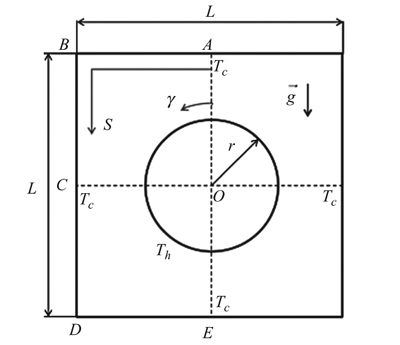
|
Lattice Boltzmann method | Cu-water Ag–water Al2O3–water TiO2–water |

|
Choosing copper as the nanoparticle leads to obtain the highest enhancement for this problem. |
| Ashorynejad et al. [118] |
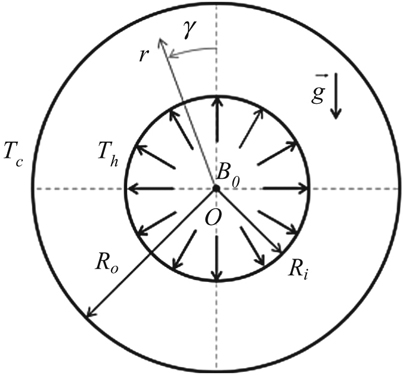
|
Lattice Boltzmann method | Ag–water |
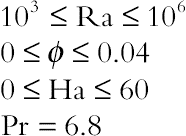
|
Flow oscillations can be suppressed effectively by imposing an external radial magnetic field. |
| Sheikholeslami et al. [119] |

|
Lattice Boltzmann method | Al2O3–water |
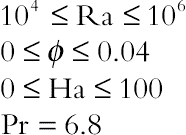
|
The enhancement in heat transfer increases as Hartmann number increases but it decreases with increase in Rayleigh number |
| Lattice Boltzmann method | |||||
| Sheikholeslami et al. [120] |

|
Lattice Boltzmann method | Cu–water |

|
Enhancement ratio increases with decrease in Rayleigh number and it increases with augment of Hartmann number |
| Sheikholeslami and Gorji [121] |
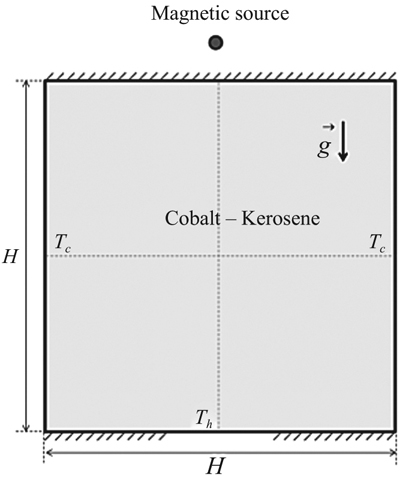
|
Lattice Boltzmann method | Cobalt–kerosene |

|
Particles with a smaller size have better ability to dissipate heat, and a larger volume fraction would provide a stronger driving force which leads to increase in temperature profile |
| Sheikholeslami et al. [122] |

|
Lattice Boltzmann method | Cu–water |
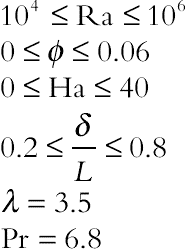
|
Nusselt number has direct relationship with nanoparticle volume fraction and Rayleigh number but it has inverse relationship with Hartmann number and position of inner cylinder at high Rayleigh number |
| Sheikholeslami et al. [123] |
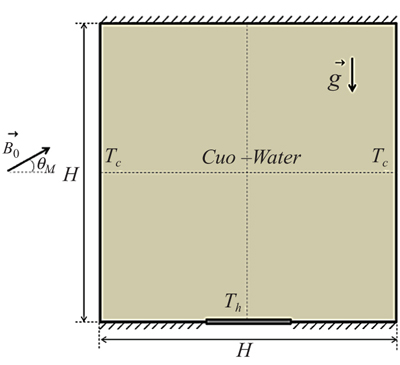
|
Lattice Boltzmann method | CuO–water |
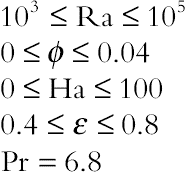
|
Enhancement in heat transfer increases as Hartmann number and heat source length increase but it decreases with increase in Rayleigh number. Also it can be found that effect of Hartmann number and heat source length is more pronounced at high Rayleigh number. |
| Sheikholeslami and Ganji [124] |
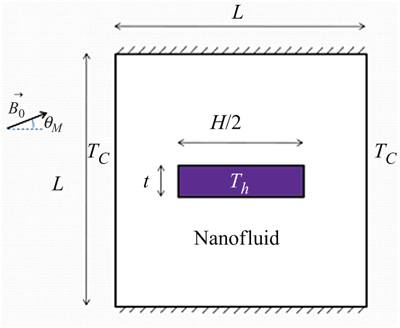
|
Lattice Boltzmann method | CuO–water |

|
Heat transfer rate and dimensionless entropy generation number increase with increase in the Rayleigh number and nanoparticle volume fraction but it decreases with increase in the Hartmann number |
| Sheikholeslami et al. [125] |

|
Lattice Boltzmann method | Al2O3–water |

|
Lattice Boltzmann method with double population is a powerful approach for the simulation of natural convection heat transfer in nanofluids in regions with curved boundaries |
| Sheikholeslami and Ellahi [126] |

|
Lattice Boltzmann method | Fe3O4–plasma |

|
Back flow occurs near the region where the magnetic source is located. Also it can be found that skin friction coefficient is a decreasing function of Reynolds number and magnetic number |
| Sheikholeslami et al. [127] |
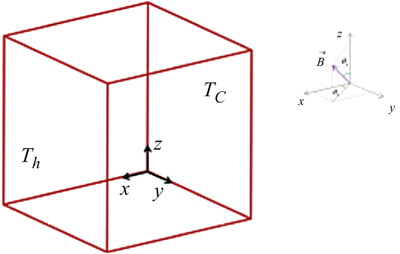
|
Lattice Boltzmann Method | Al2O3-water |

|
Nusselt number increases with increase of nanoparticle volume fraction and Rayleigh number while it decreases with increase in Hartmann number. |
| Sheikholeslami and Ellahi [128] |
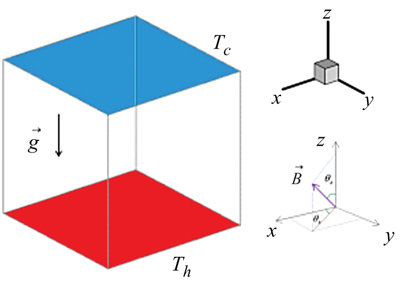
|
Lattice Boltzmann Method | Al2O3-water |

|
Applying magnetic field results in a force opposite to the flow direction that leads to drag the flow and then reduces the convection currents by reducing the velocities |
| Sheikholeslami et al. [129] |

|
Lattice Boltzmann method | Cu–water Ag–water Al2O3–water TiO2–water |

|
The effect of nanoparticle volume fraction is found to be more pronounced for low Rayleigh number as compared to high Rayleigh number |
| Kefayati [130] |
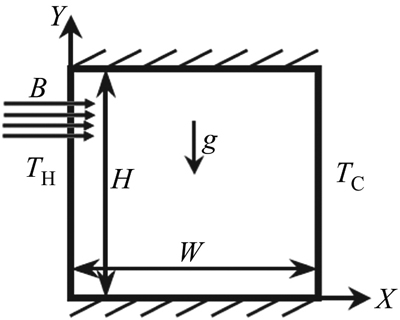
|
Lattice Boltzmann method |
Cu–water |

|
The heat transfer decreases by increment of Hartmann number. Heat transfer decreases with growth of the aspect ratio but this growth causes the effect of nanoparticles to increase. Magnetic field augments the effect of nanoparticles at high Rayleigh numbers (Ra = 105). The effect of nanoparticles rises for high Hartmann numbers when the aspect ratio increases. |
| Kefayati [131] |

|
Lattice Boltzmann method |
Cu–water |
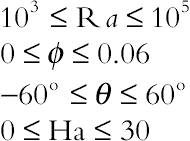
|
The heat transfer is decreased by the increment of Hartmann number for various Rayleigh numbers and the inclined angles. Magnetic field augments the effect of nanoparticles at high Rayleigh numbers. |
| Kefayati [132] |

|
Lattice Boltzmann method |
Kerosene/ Cobalt |

|
Heat transfer decreases by the increment of the nanoscale ferromagnetic volume fraction. The external magnetic field influences the nanoscale ferromagnetic at Ra = 104 more than other Rayleigh numbers as the least values were observed at Ra = 103. Heat transfer obtains the most value at Yp = 0.5 H for multifarious Rayleigh numbers, the most effect of the nanoscale ferromagnetic for Ra = 104 and 105 was perceived at Yp = 0.75H. |
| Kefayati [133] |

|
Lattice Boltzmann method |
Cu–water |

|
As the nanoparticle volume fraction and Rayleigh number increased average Nusselt number increased but opposite trends were observed when the Hartmann number increases. |
| Mahmoudi et al. [134] |
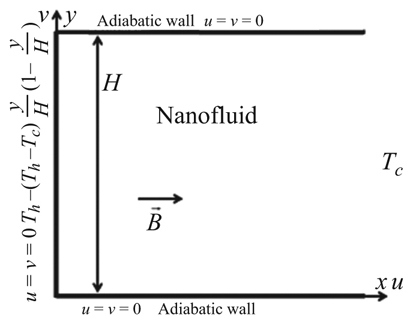
|
Lattice Boltzmann method |
Al2O3–water |

|
The nanoparticles effect is more important at a high Rayleigh number. Also, the nanoparticles effect is more important for heat generation condition (q < 0) than absorption generation condition (q < 0). |
| Mahmoudi et al. [135] |

|
Lattice Boltzmann method |
Al2O3–water |

|
The heat sinks positions greatly influence the heat transfer rate depending on the Hartmann number, Rayleigh number, and nanoparticle solid volume fraction. |
| Mejri and Mahmoudi [136] |
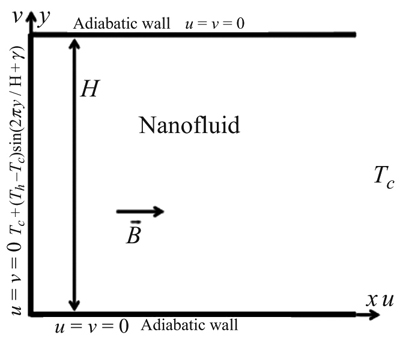
|
Lattice Boltzmann method |
Al2O3–water |

|
The heat transfer rate decreases with the increase in Hartmann number and increases with the increase in Rayleigh number. |


